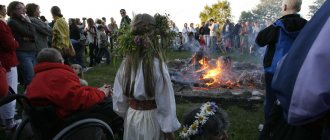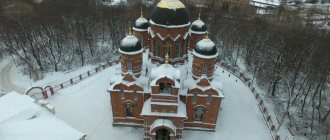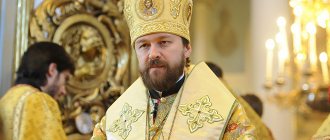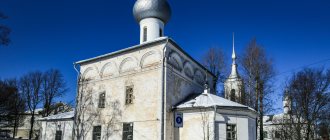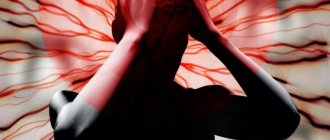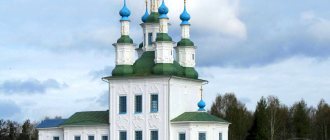The Oryol-Sevskaya, Oryol-Bryansk, Oryol-Livensk dioceses are historical milestones that preceded the formation of the Oryol Metropolis. This large diocese has undergone many changes since its creation, and has spiritually nurtured many well-known saints, ascetic hierarchs, bishops, and missionaries throughout Russia. Its history is closely connected with the events of the Oryol region.
Diocese in 1788-1820
The birthday of the Oryol Metropolis can be considered May 6, 1788, when Catherine II issued a personal decree on the division of the dioceses of the Russian Church, taking into account the new territorial division. A few days later, on the basis of the Sevsko-Bryansk Vicariate, the Oryol Metropolis with all the monasteries and churches was created. At that time, it was called the Oryol governorship, and the rulers were called Oryol - after the name of the main city of the province, and Sevsky - out of respect for all the bishops who shone in Sevsk.
The Oryol diocese included 824 churches from eight large cities with their districts from the Sevsk, Krutitsky and Voronezh dioceses. His Grace Apollos became the first bishop of Oryol-Sevsky. With the beginning of his ministry, almost all the old and dilapidated churches began to be rebuilt and replaced by more extensive new ones.
Russian Orthodox Church
Part of the Oryol Metropolis
The Oryol-Sevsk diocese was formed after the establishment of the Oryol province (May 6, 1788). In 1945-1994. the diocese was called Oryol-Bryansk, from February 25, 1994 - Oryol-Livenskaya. In certain periods, the diocese included the Bolkhov, Yelets, and Liven vicariates.
By the decision of the Holy Synod of July 25, 2014 (journal No. 67), the Liven diocese was separated from the diocese. The Synod decided to have the title of “Orlovsky and Bolkhovsky” for the ruling bishop. The Oryol diocese is included in the Oryol Metropolis.
The patron saint of the diocese is Hieromartyr John Kuksha.
Diocese today (as of June 2019)
Deaneries and deaneries
- Central (Oryol and Oryol district) - Archpriest Vasily Ivanov
- Mtsensk - Archpriest Vladimir Gerchenov
- Bolkhovskoe - Archpriest Alexander Kuznetsov
- Dmitrovskoe - Archpriest Valery Palkin
- Znamensko-Khotynetskoe - Archpriest Vasily Stoika
- Naryshkinsko-Shablykinskoye - Archpriest Oleg Suchkov
- Trosnyansko-Kromskoye - Archpriest Viktor Titov
Cathedral in honor of the Akhtyrka Icon of the Mother of God, cleric - Priest Dimitry Nikulin
Diocesan administration
- Secretary of the Metropolitan Council of Bishops - Archpriest Vladimir Sergeev
- Secretary of the diocese - priest Dimitry Nikulin
- confessor of the diocese - Archpriest Alexander Sekretaryov
- legal adviser of the diocese - priest Seraphim Yurashevich
- Head of the Protocol Service - Priest Maxim Ereskin
- assistant-secretary of the head of the metropolis - Hierodeacon Eleazar (Sukhorukov)
Diocesan departments and commissions
- religious education and catechesis chairman - priest Dimitry Stepanenkov
- for interaction with representatives of government and society, Chairman - Viktor Anatolyevich Livtsov
- for interaction with the Institute of Family and Childhood, Chairman - Archpriest Andrey Mikhalev
- Coordination Center for Maternity Protection Chairman - Archpriest Andrey Mikhalev
- for interaction with the Armed Forces and law enforcement agencies, Chairman - Archpriest Grigory Smirnov
- for interaction with the Cossacks chairman - Archpriest Vladimir Gerchenov
- Prison ministry chairman - Archpriest Sergiy Kryuchkov
- on countering the drug threat chairman - Archpriest Alexander Rodionov
- Commission (Church and Public Council) to counter the threat of alcohol, secretary - Priest Seraphim Yurashevich
- missionary chairman - Archpriest Sergiy Gavryushin
- for youth ministry chairman - priest Dionysius Kostomarov von-Dietz
- Commission for the Canonization of Saints Chairman - Archpriest Igor Chistyukhin
- pilgrimage chairman - Archpriest Mikhail Zharkov
- for Church Charity and Social Service Chairman - Priest Oleg Anokhin
- for interaction with healthcare institutions chairman - Archpriest Nikolai Evdokimov
- Architectural and Construction Chairman - Archpriest Igor Pershechkin
- church historical and archaeological chairman - Anatoly Ivanovich Perelygin
- Church Archaeological Commission Chairman - Archpriest Sergiy Kryuchkov
- information, analytical and publishing chairman - Evgeniy Anatolyevich Borisov
Monasteries
men's:
- Svyato-Uspensky 302040, Orel, Monastyrskaya Square, 3 (former address - Orel, Ermolova St., 13 a); tel.; website https://www.uspenskiy.infoi.o. Viceroy - Hieromonk Kirill (Savvin)
- Hieromartyr Kukshi 303041, Oryol region, Mtsensk district, Karandakovsky s/s, village. Frolovka; website https://www.st-kuksha.ru i.o. Viceroy - Hieromonk John (Biryukov)
women's:
- Svyato-Vvedensky Orel, st. 1st Kurskaya, 92; website orel.vinchi.ru abbess - Abbess Olympiada (Rozhnovskaya)
- Trinity Nativity of the Virgin Mary Optin 303140, Oryol region, Bolkhov, sl. Upper Monastyrskaya, 1st abbess - Abbess Eufalia (Mastepanova)
- Saint Blessed Xenia of Petersburg 303232, Oryol region, Dmitrovsky district, village. Dolbenkino abbess - Abbess Ksenia (Tarabanova)
There are 100 parishes .
Social institutions
- Orel Coordination Center for Maternity Protection “Family” Orel, st. Leskova, 17; tel.; e-mail; website vse-vmeste.ortox.ru
Mass media
- official website of the Oryol diocese
- website of the department of social service and church charity
- website of the Akhtyrsky Cathedral
Oryol Metropolis until the middle of the 19th century
For many years, the Oryol diocese was located in Sevsk due to the presence of a seminary there. In 1822, at the request of Bishop Jonah of Orlovsky, the construction of a seminary building in Orel began, which lasted 5 years.
The construction of new monasteries and the founding of women's communities and monasteries continued just as rapidly until the mid-19th century. During this period, a large number of miraculous icons appear, for example, the miraculous icon of the Mother of God of Balykino or the image of the Mother of God of Three Hands from the Mother of God of All Saints Monastery in the city of Bolkhov.
Oryol diocese at the beginning of the twentieth century
At the end of the 19th century, the Oryol Metropolis included 998 churches of various architectural structures and 44,421 parochial schools. By that time, academic education was gaining strength, which contributed to the spiritual flourishing of the province at the beginning of the 20th century.
Another spiritual wealth that the Oryol Metropolis had was the clergy. From the year of its foundation until the 20th century, the diocese was headed by 14 Bishops. There is evidence of a connection with the Oryol land of John of Kronstadt, famous throughout Russia, who followed the events of Oryol parish life and during one of his visits even gave a well-known speech about freedom of conscience at a congress of clergy held in Oryol.
On May 6, 1904, the whole city greeted Tsar Nicholas II. The entire journey of the emperor was filled with demonstrations of loyal feelings from students, representatives of classes and corporations.
Also in 1904, Princess Elizaveta Fedorovna Romanova and Prince Sergei Alexandrovich visited the city and escorted the sponsored regiment to the Russian-Japanese War. Subsequently, the princess visited the Oryol Metropolis more than once and met with Father Mitrofan, who later became the confessor of the Moscow monastery dedicated to the myrrh-bearing women Martha and Mary.
Bishops
Moscow Vicariate
- Tikhon (Yakubovsky) (August 8, 1764 - December 17, 1767)
- Kirill (Florinsky) (January 13, 1768 - April 26, 1778)
- Ambrose (Podobedov) (July 5, 1778 - April 28, 1782) [5]
- Damascene (Semyonov-Rudnev) (July 5, 1782 - September 22, 1783)
- Feoktist (Mochulsky) (January 7, 1784 - February 9, 1787)
Independent diocese
- Apollos (Baibakov) (June 5, 1788 - October 26, 1798)
- Dosifey (Ilyin) (October 26, 1798 - June 4, 1817)
- Jonah (Pavinsky) (July 22, 1817 - July 21, 1821)
- Gabriel (Rozanov) (September 18, 1821 - May 22, 1828)
- Nikodim (Bystritsky) (July 15, 1828 - December 30, 1839)
- Innokenty (Selnokrinov) (January 28 - April 25, 1840)
- Evlampy (Pyatnitsky) (June 27, 1840 - November 22, 1844)
- Smaragd (Kryzhanovsky) (November 12, 1844 - June 5, 1858)
- Polycarp (Radkevich) (July 12, 1858 - August 22, 1867)
- Makariy (Mirolyubov) (August 29, 1867 - December 25, 1876)
- Yuvenaly (Karyukov) (December 25, 1876 - December 31, 1882)
- Simeon (Linkov) (February 13, 1883 - June 3, 1889)
- Misail (Krylov) (June 3, 1889 - August 10, 1896)
- Mitrofan (Nevsky) (August 10, 1896 - January 2, 1899)
- Nikanor (Kamensky) (January 2, 1899 - March 28, 1902)
- Irenaeus (Horde) (March 28, 1902 - April 10, 1904)
- Sschmch. Kirion (Sadzaglishvili) (April 23, 1904 - February 3, 1906)
- Sschmch. Seraphim (Chichagov) (February 3, 1906 - September 16, 1908)
- Alexander (Golovin) (October 31, 1908 - December 31, 1910)
- Grigory (Vakhnin) (December 31, 1910 - January 28, 1917)
- Zinovy (Drozdov) (June 5, 1913 - ?), high school bishop. Kozlovsky
- Mitrofan (Zemlyansky) (June - August 1914), high school bishop. Yeletsky
- Sschmch. Seraphim (Ostroumov) (May 27, 1917 - August 18, 1917), high school bishop. Belsky
- Daniil (Troitsky) (April 8 - October 28, 1922), high school bishop. Bolkhovsky
- Dimitry (Gradusov) (December 1943 - February 1944) high school
- John (Popov) (March 21 - June 2, 2008), supreme, archbishop. Belgorodsky
Establishment of the Vicariate
At the beginning of the 20th century, the question of establishing a vicariate arose. The Oryol Metropolis of the Russian Orthodox Church by this time was comparable in size to the Greek, Serbian or Bulgarian, where it is governed not by one bishop, but by several, each of whom is responsible for his own direction. The large amount of work on spiritual care for the entire clergy and flock of an entire diocese, which falls on the head of the local church - the bishop, is beyond the strength of any one person. Therefore, in 1906, Archimandrite Mitrofan was elevated to the rank of vicar of the Oryol diocese.
Structure of the metropolis
The Oryol Metropolis includes the following dioceses:
- Oryol, consisting of 7 deaneries and 1 vicariate, which are located in the west of the region.
- Livenskaya, consisting of 8 deaneries, geographically located in the east of the region.
The Temple of the Akhtyrsk Icon of the Mother of God is the Cathedral of Orel
To organize social, spiritual and economic diocesan work, the following departments function:
- educational and educational;
- on interaction with government and public structures;
- on organizing work with children and families;
- on interaction with law enforcement agencies;
- to combat alcohol and drug addiction;
- charitable;
- missionary;
- canonization commission;
- on working with the younger generation.
Also under the Oryol Metropolis there is a church choir, an archaeological commission and a department involved in the construction of religious buildings.
Monasteries of the Oryol region
At the beginning of the 20th century, 9 male and 6 female monasteries were built on the land of the diocese. The first monasteries arose in the XIII-XV centuries: Bryansk Uspensky, Bolkhovsky Trinity Optin, Bryansk Petropavlovsky, etc.
In the 16th-17th centuries, when the Oryol Metropolis expanded and strengthened more favorably, monasteries were built one after another: Mtsensk Monastery, Bogoroditskaya Hermitage, Odrin-Nicholas Monastery, etc. The favorable time for monasteries was before the first Peter's reforms in 1715, when monasteries were taxed and received a ban on tonsure as a monk. During the time of Anna Ioannovna, under Elizabeth and Catherine II, the number of monasteries decreased.
By 1990, having survived persecution, the destruction of churches and the murder of priests, the Oryol diocese had only 20 operating churches out of 31 that survived. In total, there were 57 clergy left in this large region, including one bishop, 37 priests and 8 deacons, many of whom had no spiritual education.
At the end of the nineties, the activity of three monasteries was restored: the male Assumption and female Holy Vvedensky monasteries in Orel and the convent of Mary Magdalene in the Dolzhansky district. Many monasteries and churches are on the waiting list for restoration. In 2006, the Trinity Optin Monastery was restored.
Metropolis today
In 2014, the Oryol Metropolis was founded on the territory of the Oryol region, which included the Liven and Oryol dioceses. The first head of the metropolis was Anthony, Archbishop of Oryol and Bolkhov.
The Oryol Metropolis currently has 5 monasteries, more than 200 active parishes, and a large number of restored and built churches. The address of the diocesan center, where you can find out more detailed information about the current affairs of the metropolis: Russia, Orel, st. Normandy-Neman, 47.
In 1681, at the Moscow Spiritual Council, it was decided to form an episcopal see in Bolkhov
In 1681, at the Moscow Spiritual Council, it was decided to form an episcopal see in the city of Bolkhov, and add the city of Orel to it. By the end of the 17th century, there were only 12 monasteries in the Oryol region.
By the middle of the 18th century, a crisis emerged in church governance. Some dioceses were divided into several parts. In 1765, Livny was transferred to the Voronezh diocese from Krutitskaya. Here, by decree of the Holy Synod, the Seva Vicariate arose, which included the Moscow Diocese.
Church stone construction also began to spread in the Oryol region. The most important event was the emergence of religious educational institutions. In 1778, a Theological Seminary was opened in the city of Sevsk.
17 May 1788
an independent diocese was opened
In 1778, the Oryol province was established. Its territory in many ways exceeded the Oryol region, as it included part of the Bryansk and Lipetsk regions. Then the question arose again about creating an independent diocese.
At first, the Oryol province fell apart in church terms between the Sevsk, Voronezh and Krutitsa dioceses.
It existed on the basis of the Sevsko-Bryansk Vicariate. Vladyka was called Orlovsky and Sevsky. The first bishop was the Most Reverend Apollos, and his subsequent successor was Dositheus.
Within the newly formed Oryol diocese there were 824 churches, most of which were assigned to the Sevsk diocese. One of the most mature buildings in the Oryol region was the Assumption Church.
The first Bishop of Sevsky and Oryol - Bishop His Eminence Apollos
